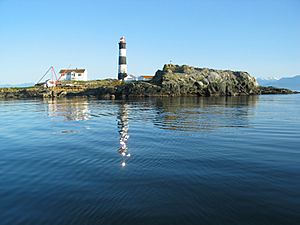Race Rocks Light facts for kids
 |
|
| Location | Next to Vancouver Island British Columbia Canada |
|---|---|
| Coordinates | 48°17′52.9″N 123°31′53.1″W / 48.298028°N 123.531417°W |
| Year first constructed | 1859–1860 |
| Year first lit | 26 December 1860 |
| Construction | stone tower |
| Tower shape | cylindrical tower with balcony and lantern |
| Markings / pattern | tower with black and white bands, red lantern |
| Height | 24.4 metres (80 ft) |
| Focal height | 36 metres (118 ft) |
| Characteristic | Fl W 10 s |
| Fog signal | (3) 60 s |
| Admiralty number | G5300 |
| CHS number | CCG 0189 |
| NGA number | 13760 |
| ARLHS number | CAN-426 |
The Race Rocks Light is a famous lighthouse located near Vancouver Island in British Columbia, Canada. It was one of the very first lighthouses built on Canada's west coast, starting its job in 1860. The British Government paid for its construction.
What makes Race Rocks Light special is that it's the only lighthouse on this coast made from rock. The stone, which is granite, is believed to have come all the way from Scotland. The top part is made of sandstone from Gabriola Island. The small group of islands called Race Rocks are found just off the southern tip of Vancouver Island. They are about 16 kilometers (10 miles) southwest of Victoria, British Columbia.
Contents
Building the Race Rocks Lighthouse
The Race Rocks Lighthouse was built between 1859 and 1860. The crew of the ship HMS Topaze and other workers helped construct it. John Morris was the person in charge of the building project.
The light first shone on December 26, 1860. This was just six weeks after the smaller Fisgard Lighthouse was lit up. Fisgard Lighthouse is located near Victoria, at the entrance to Esquimalt Harbour. In 2010, both lighthouses celebrated their 150th birthday! You can find out more about the lighthouse's history at A complete history.
How the Lighthouse Works
The lighthouse tower is 24.4 meters (80 feet) tall and shaped like a cylinder. It has black and white stripes, making it easy to spot. The light flashes white every 10 seconds. It also has a foghorn that makes three loud blasts every minute. This helps ships find their way when it's foggy.
Since 1997, the lighthouse has been automated. This means it works by itself without a person living there all the time. After it became automated, Lester B. Pearson College started managing the lighthouse station. They also look after the natural area around it, which is called the Race Rocks Ecological Reserve. In 2009, the inside and outside of the lighthouse were repaired and made to look new again.
Studying the Ocean at Race Rocks
The Race Rocks Light is one of 12 lighthouses that are part of a special science program. This program is called the British Columbia Shore Station Oceanographic Program. Since 1921, scientists have been collecting important information here. Every day, they measure the temperature and saltiness of the coastal water. This helps them understand how the ocean is changing over time.
Lighthouse Keepers
For many years, people called lighthouse keepers lived and worked at Race Rocks Light. They were in charge of making sure the light was always shining and the foghorn was working. It was a very important job to help guide ships safely. Many different keepers looked after the lighthouse over the years, including:
- George Nicholas Davies (1861 – 1866)
- Thomas Argyle (1866 -1888)
- Frederick Mercer Eastwood (1891 – 1919)
- James Thomas Forsyth (1919 –1932)
- Trevor M. Anderson (1966 – 1982)
- Mike E. Slater (1989 – 1997)

